Southern T ides
all about the water

April 2023
 Field Services Technician
Doug Deloach
Field Services Technician
Doug Deloach

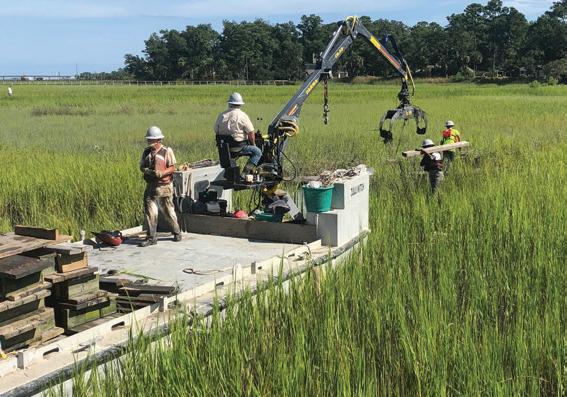
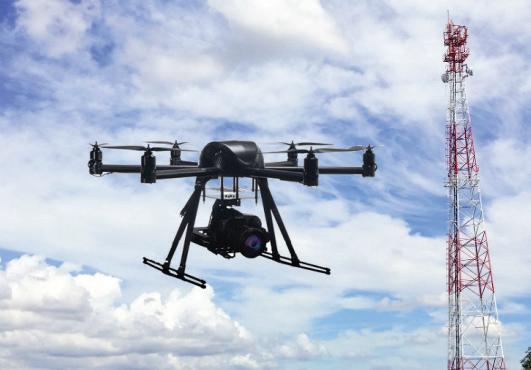


(855) 400-9858 zuludiscovery.com Working for a Healthy Coast! • Disaster Response • Oil Spill/Environmental Response • Abandoned and Derelict Vessel Removal • Dredging • Creek, River & Watershed Response • Living Shorelines/Bank Stabilization • Hydrographic Surveys • Marine Platforms, Transport & Support • ROV Services & Underwater Exploration • Environmentally Sensitive Land Clearing • Infrastructure Inspection • Construction Site Management • Industrial Inspection • Water Tank Inspection • Wireless (Cell Tower) Inspection • Catastrophic Response Program • Disaster Response Mapping To learn more visit our website or give us a call!






• BoatU.S. 24-hour dispatch services, call: 800-888-4869 • Towing service with ALL the bene ts of membership in BoatU.S. Visit us on Facebook! New Member Terms: O er available to new members only. Renewal at standard rate of $165 annually. Must call 912-507-2628 and mention Tides22 to claim o er. $115 NEW MEMBER SPECIAL Towing • Soft Ungroundings Jump Starts • Fuel Delivery For 24/7 Response, Call: 912-507-BOAT (2628)
PUBLISHER/EDITOR Amy Thurman amy@southerntidesmagazine.com
ASSISTANT EDITOR
Neva Parsons neva@southerntidesmagazine.com
DISTRIBUTION & SALES
Jay Rich jay@southerntidesmagazine.com
CONSULTING NATURALIST
John "Crawfish" Crawford subtropicalnaturalist@gmail.com
THE BITTER END COLUMNIST
Captain J. Gary "Gator" Hill theoriginalcaptaingator@gmail.com
THE RIVERKEEPER REPORT
Meaghan Gerard meaghan@ogeecheeriverkeeper.org
Contributors
Nick Riccio, Jr. Wildlife Photographer
Laurie Lohne Photography
Eddy Starnes Recipe
Rick Lavender GADNR Wildlife Resources Division
Tim Keyes GADNR Wildlife Resources Division
Michael Sullivan Skidaway Institute of Oceanography
Top: Shrimp caught on a recent black gill cruise. Photo provided by UGA SkIO

Center: Roseate spoonbills.

Bottom: Gator getting sun.

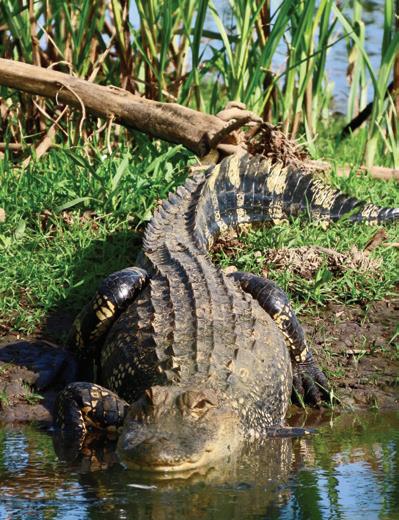
About the Cover: Alligators enjoy warm spring temps too, like this big one at the Altamaha WMA, in Darien. Check out our feature about an usual gator (pg 12) and learn more with Did You Know? (pg 21). Photo by Laurie Lohn Photography 7 Editor's Note 9 Forecasting Black Gill 11 Taste of the Tides 12 An Unlikely Winter Home 15 Riverkeeper Report 16 ICW Update 17 Business Spotlight 18 Coastal Birding Trail 19 New Aquarium Exhibit 21 Did You Know? 22 The Bitter End Copyright © 2015-2023 All content herein is copyright protected and may not be reproduced in whole or part without express written permission. Southern Tides is a free magazine, published monthly, and can be found at multiple locations throughout coastal Georgia. (912) 484-3611 info@southerntidesmagazine.com www.SouthernTidesMagazine.com Visit us on social media: www.issuu.com/SouthernTidesMagazine.com Facebook.com/southern-tides-magazine Southern Tides Magazine is printed by Walton Press, Monroe, Ga. Letters to the Editor: We love hearing from you! Questions, comments, ideas, or whatever you'd like to share, please do! Send your thoughts to any of our email addresses listed above. Reader Photos: To submit your photos, visit www.flickr.com/groups/ southerntides/ Three will be selected each month. Crew
CONTENTS
Photo by Tim Keyes, GADNR
outhern
Ides Vol. 8, Issue 8 April 2023 5 APRIL 2023 Southern Tides Magazine
Photo by Nick Riccio, Jr.
S
T







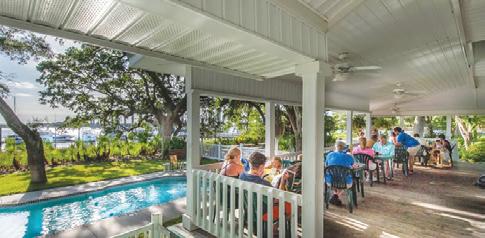


Savannah 912.312.1281 • St. Simons Island 912.297.5270 • Richmond Hill 912.312.1281 With Freedom Boat Club, you get to experience hassle-free boating in Coastal Georgia without worrying about storage, insurance or upkeep. Boat anytime you like on any of our boats and enjoy unlimited training by licensed Captains. You’ll Never Believe How Simple Boating Can Be FreedomBoatClub.com Join the club – use our boats! • Dockage and Dry Storage • Gas/Diesel • Boat Rentals • Free WiFi • Courtesy bicycles • Pool • Pump-out office@jekyllharbor.com www.jekyllharbor.com 912-635-3137 • Apps, burgers & fresh local seafood • Full bar • Indoor & outdoor dining • Live music on weekends • Open seven days Come by boat! ZACHRY'S - Providing fresh seafood in Glynn County for over 35 years! 912-319-2174 1 Harbor Road Jekyll Island, Georgia Now offering BOAT RENTALS
Spring has arrived!
Every year, as soon as we start having more warm days than cold ones, my annual bout of spring fever kicks in and I’m out of control. My mind runs in high gear 18 hours a day and my sleep is restless because even my subconscious wants to be outside grabbing every moment of my favorite season.
SPRING!
Days have gotten longer, the time for wearing suffocating winter layers is behind us, water temps are heating up (63 at print time), and it’s time to get outside.
No, springtime in the South isn’t for the faint of heart. Between the pollen, the gnats and the humidity, you have to be tough to still enjoy being outdoors, but the rewards are worth it.
So what’s there to do?
Get on the water! April is absolutely the best month to get out on the beaches and see what washes up in the waves, what’s crawling on the shoreline, and what birds are nesting and/or migrating through our area. If you have a boat, get it serviced and get it launched. Get out there and fish, explore new creeks and rivers, or take a day trip and try out a dockside restaurant you’ve never been to before. Don’t have a boat? There are several places to rent one, or you could just drive to any of the area beaches.
For a more up-close experience at eye level, put a kayak in the water. If you don't have a kayak, there are multiple rental locations available, and if you’re not an experienced kayaker there are many great guided tours all along our coast.
However you prefer to get out there, just do it. There’s nothing more relaxing and no better way to bring you back in touch with nature, than being out on the water.
Take a nature hike! April is a great month for wildlife and there are countless places to go for a hike, from nature preserves and wildlife management areas, to state parks, all along our coast.


Explore! There are countless places to visit and explore within a couple-hour drive. Any of the Revolutionary or Civil War forts (most are near water), any of the lighthouses along our stretch of coast, hike Cumberland Island and see the marsh ponies roaming free, wander among the tidal pools on Driftwood Beach on Jekyll, or pick a spot you haven’t been to (in a while or at all), pack a lunch and make a day of it.
Attend an event! Spring festival season will be starting soon, various organizations will be hosting paddle trips, and there’s always something going on along our stretch of coast. Look online for options, ask at your local marina, or join a club or organization and get involved.


Get your hands dirty! That’s right, plant something. Whether you find a sunny patch of yard and put some tomato plants in the ground or put some pretty flowers in pots, it just feels good to plant something and watch it grow.
No matter how busy your life is, it’s important to make time for things you enjoy and new experiences. So get out there, enjoy the warm weather, and experience everything our stretch of coast has to offer. Life’s too short to sit inside.
See you out there!
Amy Thurman Editor
Chief

Editor's Note
in
amy@southerntidesmagazine.com
Let a sea star wrap around your hand, watch the horses run on Cumberland Island, or do a little bird watching (like this great bllue heron, spotted on Jekyll). Get outside and see what life has to offer on our coast!
Photo by Nick Riccio, Jr.
Photo by Amy Thurman
7 APRIL 2023 Southern Tides Magazine
Photo by Amy Thurman
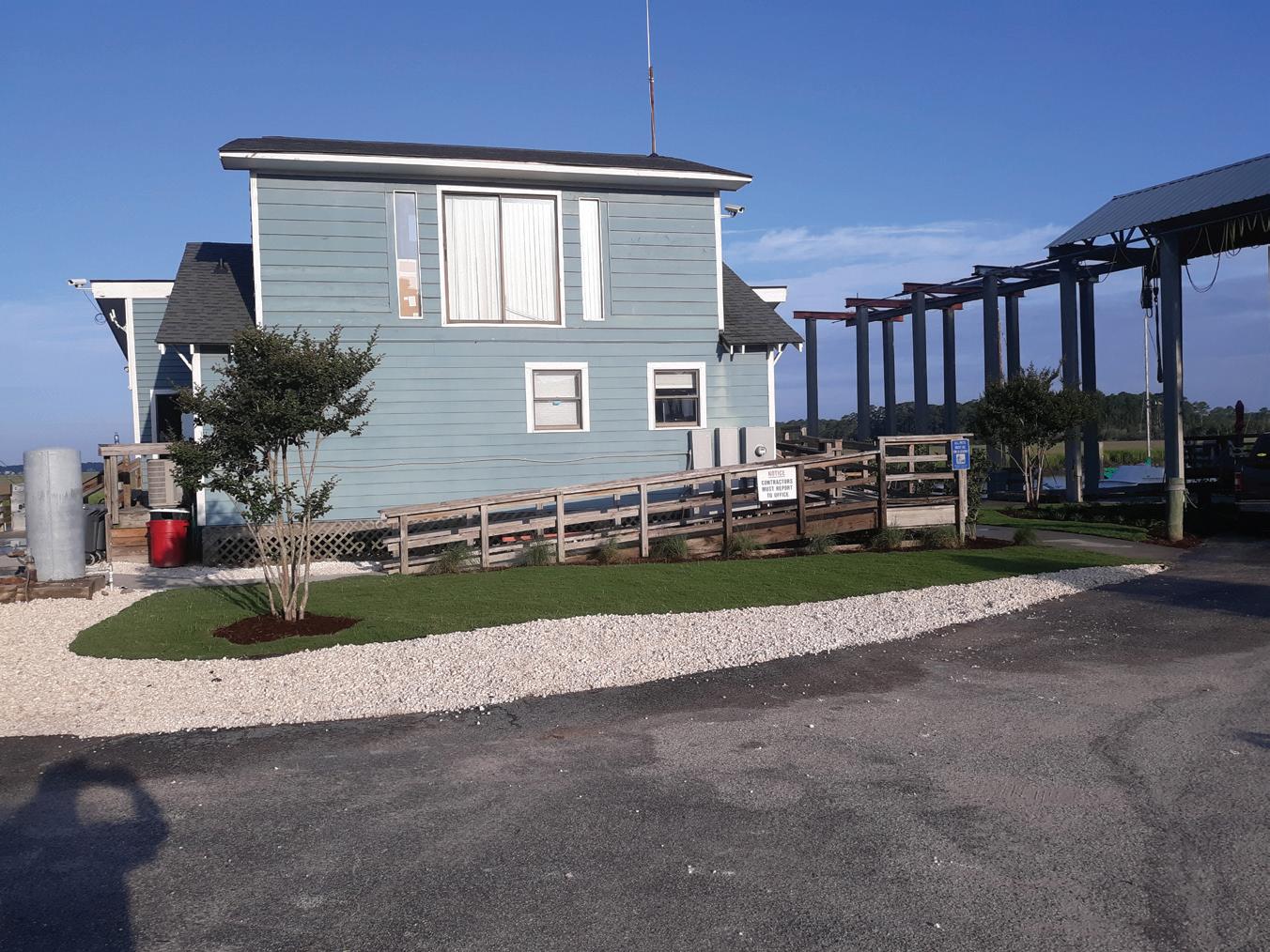



Hogans’ Marina on Wilmington Island We’ll get you on the water. Dockage Dry Storage Bait House Fuel Kayak & Boat Rentals Snacks & Drinks Parts Tackle 912-897-3474 36 Wilmington Island Road Wilmington Island Visit us on Facebook! 2827 River Drive Thunderbolt (912) 354-7777 (800) 673-9391 www.riversupply.com Life Raft Sales & Service In atable Boat Sales & Service Marine Paints Fire & Safety Equipment Yacht Chandlery & Supplies Saltwater Fishing Tackle Superior Products Competitive Pricing Outstanding Customer Service Exceptional Product Knowledge Expedited Shipping & Deliveries Your Satisfaction is our Goal Visit us on Facebook! www.facebook.com/riversupplyriverservices
Forecasting Black Gill
Contributed By UGA Skidaway Institute of Oceanography

After more than nine years of researching black gill in Georgia shrimp, scientists at UGA Skidaway Institute of Oceanography are hopeful their work may help the state’s shrimpers deal with the condition, which many shrimpers blame for reduced harvests. They want to develop a forecasting tool that would allow shrimpers to predict what kind of season they may have and prepare accordingly.
Black gill is a condition found in shrimp in the southeastern United States. The Georgia DNR first officially reported black gill in its survey data in 1996, however Georgia shrimpers anecdotally have reported its presence at least since the 1980s. Early on, no one knew the cause of black gill or its effect on shrimp, and the number of infected shrimp has varied widely from year to year—as has the number of shrimp for harvest.
The presence of black gill is seasonal. It visually disappears during the winter. It begins appearing as the water warms in the early summer and peaks in September and October, which is also the height of the commercial shrimping season. That seasonal variability also gave UGA Skidaway Institute researcher Marc Frischer a clue as to why black gill only started appearing in the last three decades. He found a link between warmer winters and a higher incidence of black gill in the shrimping season later that year.
“What happened is that our climate is changing, especially with warmer winters,” Frischer said. “And that’s what is driving this occurrence of the symptomatic black gill.
“The ciliate that causes it has probably been here forever. We don’t think it is an invasive species. We recognize it now as an impact of climate change.”
The link to winter temperatures gave Frischer insight into a way to help the Georgia shrimpers. Since a cure for black gill is not likely, the next best answer might be a forecast tool. Frischer hopes that by providing shrimpers with some idea of what they can expect out of their efforts, it might avoid the devastating consequences the shrimp industry experienced in 2013.

Frischer was asked to get involved in the black gill project after the Georgia shrimp industry hit a crisis in 2013. Local shrimpers thought they were poised for a great season, as a shortfall of Asian imports drove prices to record levels. When the Georgia shrimpers deployed their nets, however, they discovered there were hardly any shrimp to be caught.
“There was a lot less shrimp on the market, and the prices were triple what they’d been the years before,” Frischer said. “So, the shrimpers put a lot of effort into preparing for the season, and then they didn’t catch enough shrimp to pay for their fuel cost. A lot of shrimpers when bankrupt that year.”
Frischer and his team quickly uncovered the cause: the parasite black gill, a tiny, previously undescribed, single-cell ciliate growing on the shrimps’ gills (the blackening of the gills actually is a defense mechanism shrimp use to protect against the parasite). Subsequent research confirmed the condition affects shrimp in several ways, including reducing their endurance and making them more susceptible to predators. It also probably
increased mortality rates, although determining the contribution of black gill to direct mortality rates has been difficult to quantify.
“We’ve learned a lot about the parasite’s life history, what it does and why it causes black gill,” Frischer said. “We think that’s because it feeds off of living gill tissue on the shrimp. That causes the shrimp to respond to turn on its immune system, which is what results in the symptoms of black gill.”
Although the parasite is harmful to shrimp, Frischer stressed that it is not harmful to humans. “If you’ve eaten local shrimp anytime since the 1990s, you’ve eaten shrimp with black gill. I’ve never heard of any health issues for people associated with eating shrimp affected by black gill, and they still taste delicious.”
In December, Frischer hosted the sixth “black gill cruise” on the R/V Savannah, bringing together a wide-ranging group of stakeholders including, scientists, shrimpers, managers, policy makers, educators and the press to compare notes and establish connections.
“The point of this year’s cruise was to look back and see where we’ve come and chart a path forward, what we’ve learned and what we still have to learn,” he said. “We discussed challenges currently facing the fishery, and what are perhaps new opportunities.
“It’s not wiping out shrimping. But it’s not helping either. And so, the shrimpers are being compelled to learn to live with it.”
Crew and guests aboard teh December black gill cruise.
9 APRIL 2023 Southern Tides Magazine
Photo provided by UGA SkIO














• Prop Scan Technology • Propeller Repairs & Sales • Veteran Owned & Operated P R O P D O CT O R S L L C W e Al s o S e r vi c e O utb o a rd P r o ps! 912 .695 .0131 i nfo@pr o pd o ct o r sll c . c o m 3327 - B R u s s ell St r e et , Th u nd e rb olt servicesavannah@hinckleyyachts.com 2400 Mechanics Avenue, Thunderbolt (912) 629-2400 Full Range of Refit and Repair Services: Mechanical & Electrical Fiberglass & Painting Woodworking & Varnish Rigging & More Southern food with Caribbean flair, prepared with fresh local ingredients! tortugasisland@yahoo.com www.tortugasislandgrille.com 2815 River Drive Thunderbolt (912) 201-3630
Taste of the Tides
CRAB AND SHRIMP PIE
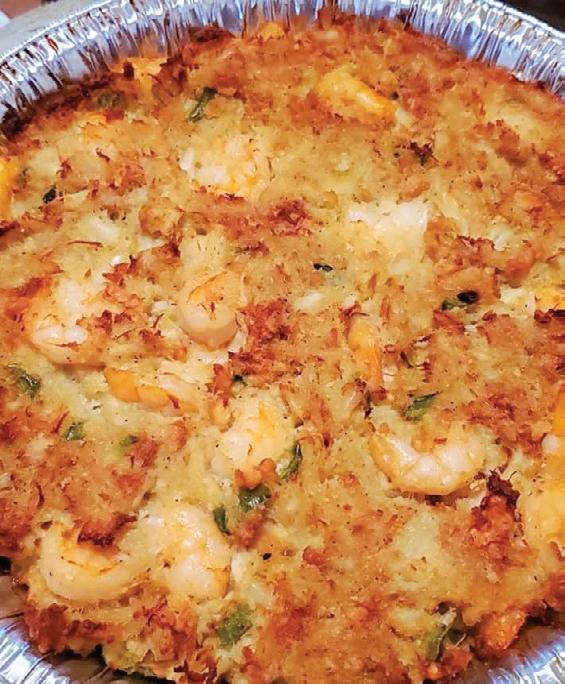
Contributed
by Eddy Starnes
What could be better than crab and shrimp in a pie? Not much! Enjoy this tasty dish for brunch or dinner, and don't forget to support your local seafood markets or catch it yourself.
INGREDIENTS
1 lb blue crab meat
1 lb wild Georgia shrimp, peeled & deveined
1 egg
1 package crackers (I use Townhouse)
½ stick butter
½ medium onion, chopped
½ green bell pepper, chopped
¼ tsp black pepper
4 tbsp mayonnaise
Additional spices if you'd like
DIRECTIONS
• Preheat oven to 350.
• Melt butter in a frying pan and add chopped onions and bell pepper. Cook until soft.
• Add shrimp to pan and cook through, stirring frequently.
• In a large bowl, mix crab meat and egg, then add shrimp and vegetable mixture, mayo, and pepper, then stir to combine.
• Crush a sleeve of crackers into fine pieces and stir in.
• Lightly grease a pie pan and spoon mixture into it
• Bake 25 to 40 minutes until top has lightly browned
Note: The filling can be baked in a pie crust for easier serving.
Do you have a seasonal seafood recipe to share?
Send it to amy@southerntidesmagazine.com and include a photo, if available.

11 APRIL 2023 Southern Tides Magazine
A Most Unlikely Winter Home
By Rick Lavender Communications and Outreach Specialist GADNR Wildlife Resources Division
probably the same gator. They set up a camera to document the use this year and even walked up on the gator sunning by the burrow.
The big reptile didn’t dive for the hole, and even seemed reluctant to go in, Moore said. “That made us think he kind of slides (in) backward.” Makes sense: For an animal almost 5 feet long, turning around in a tortoise tunnel could be trouble.
Agator walked into a burrow …
But, this actually isn’t the start of a joke. And the fact that an alligator did walk, or squeeze, into a Tattnall County gopher tortoise burrow for three winters in a row and over 800 yards from the nearest wetland makes it more fascinating than funny, according to DNR wildlife technician Matt Moore.
“This gator is traveling long distances just to spend the winter in a tortoise burrow each year,” Moore said.
Gopher tortoises are a keystone species mainly because the long, deep burrows they dig also benefit about 350 other animals. American alligators aren’t usually on that list. But the past three winters while surveying for rare eastern indigo snakes on private land in Tattnall, Moore and fellow technician Andy Day have discovered a gator in a tortoise burrow.
As Moore said, showing a talent for understatement, “When we get on our belly to look down a gopher tortoise hole, to see a 4-and-a-half foot alligator’s big smiling face looking back at you is a surprise.”
The surprise greeted them at the same burrow the last two years and at a nearby one in 2021. Moore and Day think it's
What’s puzzling is why this alligator travels so far to use this refuge. Gators often winter in dens or holes along waterways. But the burrow is farther than eight football fields from a significant water source. In between is rugged, firesuppressed sandhills scrub, plus other tortoise burrows that are closer, Moore said.
“There must be some level of memory involved. He can’t be following (last year's) scent trail. I can only assume he’s remembering that’s the place to go.”
Alligators have been spotted in gopher burrows at least twice before in Georgia (Day found one of them). Yet both were near wetlands. And neither involved a burrow used multiple years.

Moore took detailed photos of the alligator last month to help identify the animal if it’s spotted again. He also plans to check the tortoise burrow this summer to see if gophers are crawling in when the gator is gone.
“It’s still a work in progress in certain respects to fully understand what’s going on with this burrow.”
Or with this gator. “We want to see how long this goes on," Moore added. "Eventually he’s going to outgrow the burrow.”
12 Southern Tides Magazine April 2023
Opposite page: The 4-and-a-half foot gator at the entrance to the gopher tortoise hole.


Photo provided by GADNR
Right: Not the face one might expect to see when peering into a tortoise burrow!
Photo provided by GADNR
Bottom: Taking some sun beside its borrowed burrow.
Photo by Matt Moore, GADNR

































Your one-stop outboard service center for Mercury & Yamaha outboards! 2604 Causton Bluff Road • Savannah, GA (912) 376-8776 • HaleMarineInc@gmail.com Authorized service center for warranty and repair of Minn Kota and Power Pole products. $25 OFF $25 Off Annual Service on Yamaha and Mercury Outboards! Valid April 1 - June 30, 2023 Must mention coupon in Southern Tides. Fish Tales 912.727.3473 3203 Ft. McAllister Road Marina 912.727.3473 SM 605 2827 River Drive (912) 354-7777 2604 Causton Blu Road (912) 376-8776 Your authorized Yamaha dealer, serving South Carolina, Georgia and Florida. Let us help you get on the water today!
THE Riverkeeper Report

 Compiled by Meaghan Gerard Communications & Administrative Director Ogeechee Riverkeeper meaghan@ogeecheeriverkeeper.org
Compiled by Meaghan Gerard Communications & Administrative Director Ogeechee Riverkeeper meaghan@ogeecheeriverkeeper.org
Georgia Environmental Protection Division just completed a 60-day public comment period seeking input on whether or not the state should issue a permit for a proposed heavy mineral sand mine on Trail Ridge – 3 miles from the Okefenokee Swamp and 5 miles from the St. Marys River. There are concerns that the proposed mine will negatively impact the St. Marys River watershed ecosystem. The St. Marys River and its headwaters, the Okefenokee Swamp, are pristine waterways and are too important to risk with untested mining methods from a company that does not have experience in greenfield mining and has a negative track record of environmental stewardship. www.stmarysriverkeeper.org/
April is membership month for Ogeechee Riverkeeper. Supporters are the cornerstone of ORK’s work and ensure that ORK can continue our efforts throughout the watershed. There is strength in numbers and our power is multiplied when ORK can show a lawmaker or judge that the organization is advocating on behalf of hundreds of households.



Membership and donations not only protect the water but donors gain access to exclusive membership perks, including access to members-only events like guided paddles, plant walks, and more! There are options for annually recurring donations, donor-advised funds, planned giving, and corporate sponsorships as well.
With support, ORK has:
◆ Set up comprehensive monitoring stations around the Hyundai megasite
◆ Created a citizen tool kit for responsible development
◆ Pushed for legislation changes around ‘soil amendments’ to control chicken sludge
◆ Added litter traps in Savannah and Statesboro
◆ Led a comprehensive project to Protect the Vernon River
◆ Provided educational opportunities and virtual recreational resources

◆ Welcomed new staff, including an upper watershed representative and a legal director www.ogeecheeriverkeeper.org/join
 Ogeechee River at Kings Ferry
Ogeechee River at Kings Ferry
15 APRIL 2023 Southern Tides Magazine
Photo by Billy Harrell
VISIT THE SWAMP
















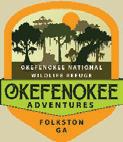





































 Contributed By BoatUS
Contributed By BoatUS



Waters have been getting deeper, improving navigation, safety and vessel access along the 1,100-plus-mile Atlantic Intracoastal Waterway since Congress began investing in the waterway as a continuous system across state boundaries and U.S. Army Corps of Engineers Districts. Before the waterway was recognized as Marine Highway 95 by the U.S. Department of Transportation, severe shoaling and thin waters in certain locations were threatening safe navigation and the passage of vessels.
Since 2016, the estimated $120 million bill for dredging costs to return the waterway to its originally authorized width and depth has been halved, with projects completed from New Jersey to Florida. More recently, the 2021 Bipartisan Infrastructure Law (BIL, formerly known as the Infrastructure Investment & Jobs Act) delivered $20.25 million in additional funding for upland placement area maintenance in North Carolina. BIL will also fund an additional $7.47 million in New Jersey dredging projects.




The job isn’t done, however, and at the recent annual flyin to meet with Congressional representatives, in Washington, D.C., Atlantic Intracoastal Waterway Association (AIWA) board members stressed efforts needed to address the still-significant backlog of unmet dredging needs.
















“AIWA’s efforts showing the importance of continued commercial and recreational vessel activity along America’s Marine Highway 95 is having an impact,” said AIWA executive director Brad Pickel, “But there is still work to do.”




More recent waterway funding projects have addressed the need for important maintenance on upland areas where dredge material is deposited. “Without these upland locations we cannot continue to dredge and keep the channel clear,” said Pickel.





















Joining AIWA in Capitol Hill legislator and staff discussions were representatives from BoatUS, National Marine Manufacturers Association, and other AIWA board members.
BoatUS government affairs manager and AIWA board member David Kennedy added, “In the last 10 years, we have done a good job helping the U.S. Army Corps of Engineers identify unmet dredging needs. We want to ensure evolving trouble spots are also identified.”


Pickel, Kennedy and other AIWA board members met with 12 congressional offices including Reps. Nancy Mace (SC), Jen Kiggans (VA), Buddy Carter (GA) and Greg Murphy, M.D. (NC). “We greatly appreciate these legislators who are looking out for the waterway,” added Kennedy.

CIRCA 1870 OODBREA HOUSE G D BED & BREAKFAST INN
andard gue r ms & two suites, all wi large private ba r ms. ay wi us and visit Cumberland Island and hi oric . Marys! Pet friendly. Dietary needs met. Call for special Sou ern Tides Rates! (912) 882-7490 www.g dbreadhouse.com info@g dbreadhouse.com 209 Osborne . . Marys, Georgia
FOLKSTON,GEORGIA DISCOVER BOTH EXPERIENCES WITH A MULTI-DAY PASS ADVENTURE AWAITS IN THE OKEFENOKEE SWAMP
400,000+ ACRES TWO WAYS TO EXPLORE GUIDED BOAT TOURS KAYAK & CANOE RENTALS BIKE RENTALS NATURE TRAILS OBSERVATION TOWERS WILDLIFE CENTER TRAIN RIDES & MORE! 912-283-0583 912-496-7156 OKESWAMP.ORG
Four
WAYCROSS,GEORGIA
ICW Update
Business Spotlight: Jekyll Harbor Marina



 By Neva Parsons Assistant Editor
By Neva Parsons Assistant Editor
Jekyll Harbor Marina, located at 1 Harbor Road, on the west side of the popular island, has been in operation since 1991. The newest owners, Zac and Stephanie Gilbert, purchased the marina in the fall of 2020 and channeled their enthusiasm, expertise and energy into a dream project: transforming their new business into the top marina destination in the Southeast.
Both Stephanie and Zac have worked in the marine industry since 1994, and purchasing their own marina was their next step. The family spent their first 18 months in residence living on their boat but have recently bought a house on the island. Relocating from Florida to seize this opportunity was a no-brainer according to Stephanie. “Jekyll Island is such an amazing and beautiful place – what’s not to love?”
Getting to know their new community and watching the business grow have been the best part of the Gilberts’ venture. Dockage is a mix of locals and transient customers, with repeat transient customers coming back season after season. Dry storage is mostly Jekyll and St Simons Island folks, but customers also hail from Atlanta, Fernandina and other locales all over the Southeast.
In addition to having “the best sunset views” Jekyll Harbor offers basic services like dockage, dry storage, boat rentals, and fuel, as well as a menu of amenities including everything from an onsite restaurant/bar, Zachry’s Riverhouse,to free high-speed wi-fi and a dog walking area to marina carts and bicycles to explore the island.
The Gilberts have recently partnered with Mercury Marine in offering their full line of products and there are more plans in the works.
jekyllharbor.com 17 APRIL 2023 Southern Tides Magazine
Springtime - For the Birds
Contributed By GADNR Wildlife Resources Division
Photos by Tim Keyes, GADNR
Springtime is prime time along Georgia’s Colonial Coast Birding Trail to see birds decked out in beautiful breeding plumage.


Wildlife biologist Tim Keyes of the GADNR said spring is when “even ordinarily drab birds look their best.” The 17 sites on the Colonial Coast Birding Trail offer an entryway to this world of color. “The trail encompasses all the diversity of habitats and bird species the Georgia coast has to offer,” Keyes said.
With spring migration ramping up, millions of birds from warblers to shorebirds and even insects such as butterflies and dragonflies are returning to their breeding grounds. Three sites that exemplify the variety of the birding trail and the region’s rich wildlife and history are Fort Pulaski National Monument, Harris Neck National Wildlife Refuge and Jekyll Island’s South End Beach.
Fort Pulaski National Monument near Savannah covers 5,600 acres at the mouth of the Savannah River and includes Cockspur and McQueen’s islands and the adjacent salt marsh. This is an excellent place to spot migratory songbirds such as warblers and tanagers during spring. Clapper rails, seaside sparrows and marsh wrens can be seen or heard in the marshes around Fort Pulaski throughout the year.
Shorebirds can best be seen along the shoreline at high tide. The beach at Fort Pulaski, created as part of Savannah shipping channel maintenance, provides additional roosting sites for birds. Fort Pulaski is also fascinating relic of the Revolutionary War, with nearly 200 years of history on display.
Moving south, visitors at Harris Neck National Wildlife Refuge near Townsend can explore more than 2,700 acres of saltwater marsh, freshwater impoundments, mixed deciduous forests and open fields. Harris Neck has the largest wood stork colony in the state, and includes many other nesting wading birds, as well.
Spring is an excellent time to see nesting birds interacting with their young. The refuge is even one of only two sites in Georgia where roseate spoonbills have been confirmed nesting (though not annually). Woody Pond on the refuge offers excellent opportunities to see and photograph wading birds. For painted buntings, one of the more colorful migrants, check out the feeders at the refuge offices and shrubby habitat around Harris Neck in late spring.
For more beach birding, the South End Beach on Jekyll Island near Brunswick provides excellent chances to see congregating shorebirds and seabirds. It is very common to encounter thousands of birds resting on the edge of the water. (But please don't disturb resting birds: Give them a wide berth.) This is also the island’s primary nesting area for Wilson's plovers in spring and summer, so watch for chicks being corralled by
their parents. Most Wilson’s plover nesting areas are roped off and marked with signs.
To access the South End Beach, park at St. Andrews Beach Park or the Jekyll Island Soccer Complex (Glory Beach Access) and walk south. From either location it is a little more than a half-mile. The St. Andrews route is not accessible during higher tides. Please also follow ordinances concerning dogs on the beach.
Whether you want to watch a wood stork feeding its fluffy young, follow the twitchy movements of the Wilson’s plover or search for elusive saltmarsh sparrows in the reeds, the Colonial Coast Birding Trail has something for you in the spring.
All told, some 300 species of birds – 75 percent of the species reported in the state – have been seen at trail sites. The trail also features opportunities to see other wildlife, including big alligators, croaking frogs and hanging Spanish moss.
Learn more at www.georgiabirdingtrails.com and on DNR’s Go Outdoors GA app. The free app, which allows you to check off species seen on the trail, can be downloaded at the Apple or Google Play store.
Top: A painted bunting
18 Southern Tides Magazine April 2023
Bottom: A male, black-throated blue warbler.
New Aquarium Exhibit
By Michael Sullivan External Affairs Manager UGA Skidaway Institute of Oceanography
Anew display at the UGA Marine Extension and Georgia Sea Grant’s aquarium on Skidaway Island translates the complex life cycles of marine animals into an easily understood snapshot of the ocean ecosystem. The display was created by UGA Skidaway Institute of Oceanography scientist Adam Greer, UGA graduate student Taylor Kilgore and the UGA Aquarium staff.
For the past several years, Greer has worked with Skidaway Institute scientists Marc Frischer and Jay Brandes to study the impacts of a little-known gelatinous organism called a doliolid. Although small – only about the size of a pencil eraser – doliolids are a major component of the marine ecosystem, with a remarkable capacity to reproduce and form dense aggregations known as “blooms.” Greer and colleagues wanted to help a larger audience appreciate the beauty of doliolids, but at the same time, help them understand that doliolids have a complicated life cycle that researchers are just starting to resolve with camera technologies coupled to other scientific sampling approaches.
“The ‘Life Cycles in the Sea’ idea was an extension of this concept to include the huge majority of life forms that spend part of their lives within drifting plankton communities,” Greer said. “We want people to understand these early life stages can’t control where they go and are sensitive to changes in their environment.
“Therefore, we need to do our part to ensure the early life stages have good water quality, so these animals we care about can complete their life cycles.”
The display, which was funded by the National Science Foundation, shows how many ocean animals, including blue crabs and popular fish species that grow much larger as adults, begin their lives as small (1 mm or so), drifting plankton that must survive these vulnerable life stages to reach adulthood. It also includes a video that demonstrates how scientists are using new technologies, like towed camera systems, to study where

these plankton live and what kind of environments they are encountering.
“This includes the physical properties of the ocean water where they live, such as the depth, salinity and temperature,” Greer said. “And, also, the biological characteristics, such as the predators and prey they might encounter.”
Greer credits the staff at the UGA Aquarium with helping to narrow their general idea and giving the public a strong and understandable “take home message.” The aquarium staff used their experience to advise Greer on all aspects of the exhibit to have the most impact on visitors. They helped Greer better understand what phrases and visuals would resonate with audiences of different ages and interest levels.
“We want our visitors to leave here with well-rounded knowledge of Georgia’s local ecosystems, and plankton are an important part of that,” UGA Aquarium curator Lisa Kovalanchik said. “It’s hard to have a live exhibit with organisms so small, but an interactive display is a great way to fit that need while engaging visitors of all ages.”
Kilgore, a master’s student in marine sciences at UGA, worked with Greer and the aquarium staff to design the exhibit and to maximize its impact. She also viewed hours of video footage collected by Savannah College of Art and Design students who joined the scientists on a research cruise. Kilgore edited the footage down to a two-minute video that shows how the camera system is deployed.
“We want people to understand that the life cycles of ocean animals are often complicated and require huge changes in both their size and lifestyle,” Greer said. “Sampling technologies, like the towed camera system shown in the display, are helping us understand the environments that these early life stages experience.”
The UGA Aquarium is open Monday through Friday from 9 a.m. to 4 p.m. and Saturdays from 10 a.m. to 5 p.m. Learn more about visiting the facility at gacoast.uga.edu/aquarium.
New interactive exhibit explains lifecycles.
19 APRIL 2023 Southern Tides Magazine
Photo provided by SkIO

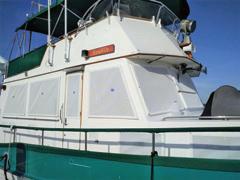











Anglers Wanted! Tournament Dates: April 27, 28, 29 (1 day, Captain’s Choice) 1st Place: $25,000 (Based on 25 boats) All proceeds benefit Shriners Hospitals for Children Sponsorships are tax deductible. For Info, visit: AleeAnglers.org MM CANVAS Dodgers Biminis Enclosures HVAC A/C Installs Repairs SYSTEMS Electrical and Mechanical 912-484-8577 MickeysMarine@Hotmail.com MickeysMarine.com Facebook.com/MickeysMarine One hour lesson, followed by a one hour rental All gear included!! Reserve today!! info@eastcoastpaddleboarding.com www.eastcoastpaddleboarding.com (912) 484-3200 Join us on Facebook! Learn to Paddleboard! $40 Intro Special! We’ll come to you! • Catering at your dock • Food cooked fresh to order • Menu designed to your needs • Call ahead service Facebook.com/TheBurgerBoatSAV instagram.com/theburgerboatsav Parties • Open Houses Fishing Tournaments • Poker Runs (912) 695-2617 (315) 406-0804 theburgerboat.com steviedsenterprises@gmail.com
Did You Know?
American alligators are more closely related to birds than to lizards!

AMERICAN ALLIGATOR
Alligator mississippiensis
Biology
Keystone Species
◆ Water retained in gator holes help other species survive, making them vital to freshwater ecology throughout the southeast.


◆ Wading birds nest over bodies of water in part due to the protection provided by alligatorsracoons and other predators can't reach the nests and steal eggs or chicks.
◆ They have up to 80 teeth.
Compiled
by Neva Parsons and John "Crawfish" Crawford
◆ While most reptiles have 3-chambered hearts, alligators have four chambers, like birds.
◆ Their retinas reflect light, giving them great night vision, and also giving their eyes a red glow at night.
◆ Sex is determined in the egg during incubation - warmer temps within the eggs will result in males, while cooler temps will result in females - the opposite of turtles.
◆ Males can average 10-12 feet and weigh 500-600 pounds.
Fun Facts
◆ Alligators use their tails to propel themselves through water.
◆ These ambush predators use their tails for propulsion to lunge out of the water, fast enough to grab a flying bird.
◆ They have no vocal cords, but bellow by inflating their bodies with air and expelling it. The force is so great that water droplets on their backs actually vibrate and the sound can be heard and felt for great distances.
◆ South Florida is the only place on earth where alligators and crocodiles are found together.
Males are very territorial and after reaching sexual maturity, will range great distances seeking territories of their own, like this big fella' at Horton Pond, on Jekyll Island.
Baby alligators will stay with mom for about two years before she boots them out.
Photo by Laurie Lohne Photography
Photo by Nick Riccio, Jr.
21 APRIL 2023 Southern Tides Magazine
Photo by Nick Riccio, Jr.
Bitter End
TALKIN' THE TALK
By Captain J. Gary "Gator" Hill

Mtrain, which means it’s time to throw off the boat cover and fire up old Betsy. Each spring I talk about the mechanical aspects of getting ready for boating season but this spring I’m going to stray away from that routine and talk about talk.
Don’t let the picture fool you. Even though that’s a radio, for this purpose it's a symbol. What is a radio? Simple. It’s a device for communicating. We all know that when using one, it’s important to be clear and concise. It’s important to do the same on our vessels, which brings me to the gist of my point.

As a veteran, communication and time have been integral factors in my life from a young age. Yet, I’ve found through the years that many people do not communicate very well. Even those of us who are intelligent and articulate can sometimes lack the execution or forethought required for effective communication.
But let’s start with time. When planning a boat outing and you have friends or family meeting you at a dock or launch ramp, be sure the meeting time is agreed upon and confirmed with all parties. I’ve witnessed many occasions when a party is running late, setting off a ripple effect that ruins the mood for the entire trip.
As the captain of your vessel, take responsibility for the effect you have on those around you, not just within your party. If you’re picking your party up at a marina and they’re running late, don’t tie up and sit at the dock. Many marinas have limited dock space, so be courteous of others waiting to load or unload. Having run a marina for a few years, I’ve seen this happen time and again. Same thing applies to the limited area around boat ramps. So basically what I’m saying is, if you see that others need to use the space, move your boat out into the creek and sit at idle until your party arrives, or move to an unoccupied space and tie off a line, but move out of the loading and unloading area.
Now, let’s get into the meat: the actual communication between individuals aboard the boat.
As a professional boat captain, I find that a good mate can make a bad captain look good, but the reverse is true; a bad mate can make a good captain look incompetent. The easiest way to avoid looking bad (or lost tempers) is to discuss what you’re going to do with whoever is handling lines for you. Talk about what the wind and currents are doing and how you’ll be maneuvering, what your thoughts are from behind the wheel and what their responsibilities are as line handlers. This
most importantly can prevent injuries. I have seen heated
acknowledgement. Don’t just say “I plan on coming to the dock at full speed, then when
Although in your mind you may understand a day running a tour boat. I work with the same
Captain Gator has spent the past several decades truly living the salt life, from living on and racing sailboats, to being a paddle guide, to becoming a 100-ton master and working in the tour boat industry. A strong love of history and the water has shaped him into becoming one part educator, one part entertainer, and one part storyteller. When asked if he is a native, his reply is yes, by osmosis.
TheOriginalCaptainGator@gmail.com
THE 22 Southern Tides Magazine April 2023
#17 18th Street, Tybee Island



3 Bedroom, 3 Bath, 1050 sq feet.



Nestled under the large oak trees is this historic Tybee cottage. Everything about it is perfect and unique in “Tybee’s Little Pink Cottage.” The entire home was totally and lovingly renovated in 2015. All of the original finishes remain to keep that perfect Tybee cottage feel. Baths were updated to give all of the modern conveniences. Steps to the beach and convenient to lots of shopping and restaurants. The yard is a huge lot with lots of entertaining areas to include an amazing firepit surrounded by pavers and overhanging oaks. There are three bedrooms and two of them are onsuite. The third has two sets of bunk beds. Fold out sofas as well. Room for everyone. After enjoying a wonderful meal upstairs, move to the screened porch or the open air but private first floor. It is ready for play time. Pool table, ping pong table, shower and a man cave with comfortable furniture and large TV. Nothing left out. A place for all to enjoy Tybee and its relaxing atmosphere.

$999,999

YourTybee IslandGetaway! 912.224.0927 lyn@coldwellbanker.com www.lynmccuen.com @lynmccuen 6349 Abercorn Street, Savannah 912.352.1222 • MyCBHomes.com
ACCESS REALTY


 Field Services Technician
Doug Deloach
Field Services Technician
Doug Deloach












































































 Compiled by Meaghan Gerard Communications & Administrative Director Ogeechee Riverkeeper meaghan@ogeecheeriverkeeper.org
Compiled by Meaghan Gerard Communications & Administrative Director Ogeechee Riverkeeper meaghan@ogeecheeriverkeeper.org




 Ogeechee River at Kings Ferry
Ogeechee River at Kings Ferry


 Contributed By BoatUS
Contributed By BoatUS










 By Neva Parsons Assistant Editor
By Neva Parsons Assistant Editor


























